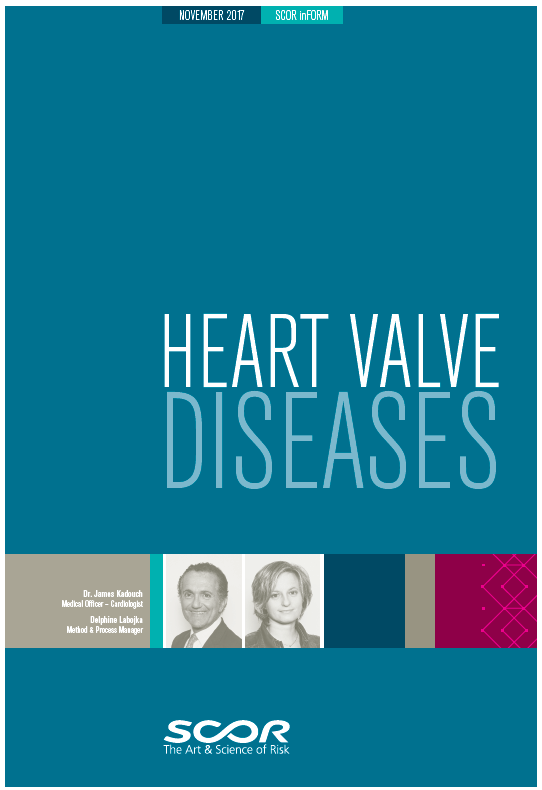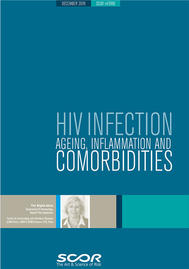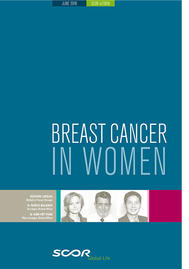Reinsurance is a knowledge industry, combining technical expertise and experience with developments in science. In addition to the many tools we use to conduct our activities — models, databases, pricing tools, reserving tools and so on — we also need personal judgments, human expertise, convictions, feelings even, to correctly underwrite. This is what we call the art of underwriting.
Expertise is an accumulation of learnings and experiences. Webinars are one way that SCOR shares expertise. During 2017, our medical team produced four webinars:
- Mitral Aortic Valvular Diseases (May 2017), Dr. James Kadouch
- Somewhere over the Growth Chart: Juvenile Obesity (July 2017), Dr. Regina Rosace
- Lynch Syndrome (October 2017), Dr. Bill Rooney
- Obesity & Opioid Addiction (December 2017), Dr. Richard Braun
Recordings of these webinars are available on the SCORcast page of our Knowledge Center. If you would like to attend future webinars, please email your name, title, company name and email address to PGranzin@scor.com.
In addition to presenting quarterly webinars, our medical team in the Americas frequently presents at industry meetings, contributes to industry publications and provides specialized training to clients.
During 2017, the medical team presented during the Association of Home Office Underwriters annual meeting, the Canadian Institute of Underwriters, the annual meeting of the ACLI and several other regional underwriting meetings as well as numerous presentations for individual client companies and our SCOR underwriters.
The Art & Science of Risk
Science is at the heart of SCOR’s DNA. SCOR researchers, medical directors and other experts share scientific developments and research results in SCOR inFORM, a newsletter which has covered a range of medical topics during the past 18 months. These and other publications are available in the Resource Library of the SCOR website.
 Heart Valve Diseases
Heart Valve Diseases
Although the prevalence of heart valve diseases is low in the general population — around 2.5% — it is much higher in patients aged 75 years and older, reaching 10%–15%. The most common valve diseases are mitral regurgitation (mitral insufficiency) and aortic stenosis, which affect three patients of four. Then comes aortic regurgitation (aortic insufficiency), followed at some distance by mitral stenosis.
Improvements in healthcare during the past 30 years have contributed to a change in the distribution of causes of valvular heart disease. Thus, rheumatic valve disease, which once was predominant in young subjects, has gradually become less common. On the other hand, with the increase in life expectancy, degenerative causes have become more frequent. Moreover, it remains likely that the number of cases will continue to grow as the population ages.
 Cancer Project
Cancer Project
The increasing cancer incidence, the high prevalence of patients cured from cancer or living long-term – with or without recurrences – and the progress made in diagnosis and therapy have led to an increasing number of patients diagnosed with ’early‘ or low-stage cancers, often having better prognosis, more likely to have curative treatment, and giving rise to more so-called ‘long term survivors’.
Underwriters will then increasingly be reviewing patients with prior history of cancer. To properly balance the task of developing novel insurance products with the changes in cancer-related prognosis, algorithms and related simplified prognostic factor calculators have been developed, allowing accurate identification of categories of patients at risk for earlier relapses. This approach has also shown that a prior history of cancer does not preclude insurability at an affordable rate.
 HIV Infection, Aging, Inflammation & Comorbidities
HIV Infection, Aging, Inflammation & Comorbidities
Since the introduction of the first antiretroviral therapies (ART) around the end of the 2000s, it has become clear that benefits of these treatments were considerably greater than their side effects, especially when introduced early. However, in spite of major progress made in treating HIV, these drugs cannot eradicate the infection and must be taken for life.
While ARTs are very effective at preventing AIDS, a lethal complication of HIV infection, a different complication of HIV infection has been discovered. Long considered, incorrectly, as a side effect of treatment, this long-term systemic inflammation results from chronic infection. This infection of the immune system induces a chronic, general inflammation that leads to accelerated aging of the immune system. It also leads to cardiovascular, bone and neurological complications and contributes to the emergence of cancers, independently of the immune deficiency.
Complications of chronic inflammation are all the more serious the later the treatments are initiated. However, fresh hopes are emerging with the most recent epidemiological data suggesting that early introduction of ARTs, continued without interruption, could eventually limit the incidence and severity of comorbidities associated with the chronic inflammation caused by HIV.
 Breast Cancer in Women
Breast Cancer in Women
Breast cancer in women is a real public health issue. All doctors, whatever their specialty, are confronted to some extent with patients with this type of tumor. It is the second most common type of cancer in the world. Breast cancer is responsible for more than 520,000 deaths each year, and is the fifth most frequent cause of death in the world.
Breast cancer represents 25% of cancers diagnosed worldwide and 31.5% of all malignant tumors identified in France. The figures sometimes translate an extremely heterogeneous reality of tumor pathology, in particular wide geographical and ethnic disparities. Recent epidemiological data as well as new diagnostic and therapeutic techniques, have led to the risk connected with cancer in general and breast cancer in particular being reevaluated.
For a copy of these or other inFORM newsletters, email your name, title, company name and email address to PGranzin@scor.com.

